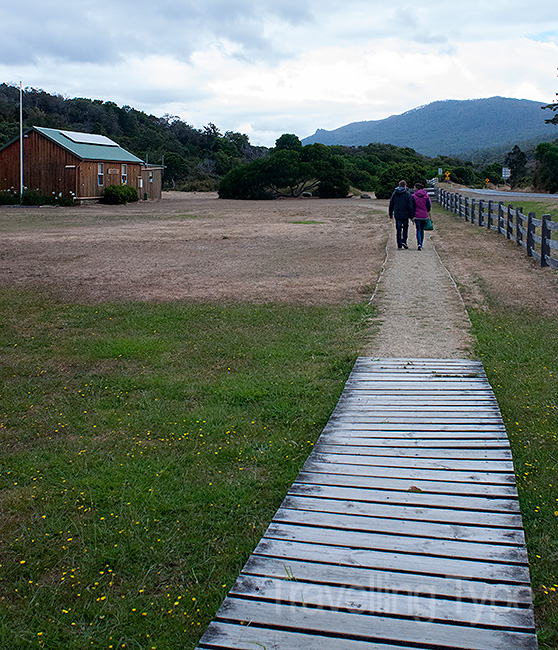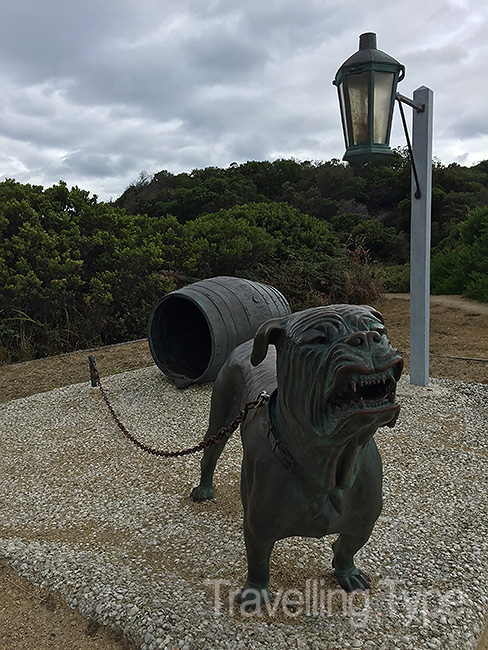“The grey and the grisly, the rough and the smooth, the crop-eared and lop-eared, the gaunt and the grim”.
These were the words used by draughtsman and painter Harden Melville (in 1837) to describe Tasmania’s Dog Line, a savage canine demarcation that prevented escape from Australia’s premier convict settlement, Port Arthur. They could almost describe my day last Saturday too, as I wandered along the old line, past the frayed remains of Australia’s oldest military building beneath a somber sky.
1831 – Birth of the Dog Line
In 1830, convicts made desperate and often successful attempts to breakout of Port Arthur. To halt such activity, an Irish chap named John Peyton Jones introduced a daring Dog Line across the Eaglehawk Neck isthmus the following year. The isthmus is the only land access to Port Arthur.
In 1832, the Officers’ Quarters were built at the isthmus (above), along with a guardhouse, a store and jetty. At first the dogs weren’t particularly vicious and the plan was unsuccessful. However, soon dog numbers increased and they were even stationed on platforms jutting out to sea. Furthermore, the dogs were isolated on chains and became particularly savage.
By the mid 1830s, Jones’ plan was working and he became well respected among his colleagues. On his Dog Line, the slightest noise would alert soldiers to a convict escape. It must have been quite the site too, as the dogs – some of which were bloodhounds – lived in wooden barrels or small huts and were chained up day and night. Behind the dogs were lamps about four feet off the ground which illuminated any wayward activity.
A few daring attempts were made to cross the Dog Line, such as that of Billy Hunt, a convict who disguised himself under a kangaroo hide and endeavoured to bounce his way to freedom. Unfortunately for Billy, some hungry guards spotted what they thought was a roo and tried to shoot it. Billy was forced to surrender.
The Dog Line, however, wasn’t impenetrable, as was demonstrated by a considerably crafty convict named Martin Cash, who managed to cross it twice. He escaped into the wilderness only to be dragged back in chains months later. For his efforts, Cash earned legendary status among his peers and was sent to Norfolk Island for the remainder of his life.
The Dog Line operated right up until the closure of Port Arthur in the 1870s. Today, as I explored the old route, past the Officer’s Quarters and the Eaglehawk Neck Community Hall, all was quiet. There was not a pooch in sight, except for the statue tied to a barrel. To the west of the statue, wind swept across the gloomy mudflats of Eaglehawk Bay.
I crossed Eaglehawk Neck to the eastern side of the isthmus and gazed upon Pirates Bay, an imposing stretch of coastline with its forested hills and sweeping beach. The isthmus is only some 30 metres across at its narrowest point.
A good place for a dog line.
A Few facts
The Dog Line at Eaglehawk Neck is just over an hour’s drive from Hobart. The Officers’ Quarters, which is allegedly the oldest military building in Australia, is today a museum and depicts life in the area in the 1800s. Unfortunately it was closed when I wandered past. Entry is free.








1 thought on “The Savage Dog Line at Eaglehawk Neck, Tasmania”